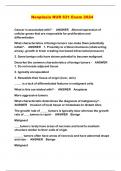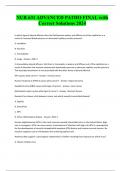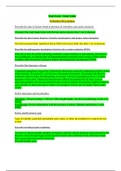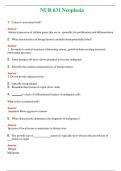Nur 631 neoplasia - Study guides, Class notes & Summaries
Looking for the best study guides, study notes and summaries about Nur 631 neoplasia? On this page you'll find 4 study documents about Nur 631 neoplasia.
All 4 results
Sort by
NUR 631 ( LATEST 2024 / 2025 ) NEOPLASIA | A SOLVED 100% CORRECT

-
Neoplasia NUR 631 Exam 2024
- Exam (elaborations) • 13 pages • 2024
- Available in package deal
-
- $9.49
- + learn more
Neoplasia NUR 631 Exam 2024...

-
NUR 631 ADVANCED PATHO FINAL with Correct Solutions 2024
- Exam (elaborations) • 62 pages • 2024
- Available in package deal
-
- $11.49
- + learn more
NUR 631 ADVANCED PATHO FINAL with Correct Solutions 2024 In which type of pleural effusion does the fluid become watery and diffuse out of the capillaries as a result of increased blood pressure or decreased capillary oncotic pressure? A. exudative B. Purulent C. Transudative D. Large - Answer -ANS: C In transudative pleural effusion, the fluid, or transudate, is watery and diffuses out of the capillaries as a result of disorders that increase intravascular hydrostatic pressure or decre...

-
Grand Canyon University:NUR 631 Final Exam Study Guide (Fall Session)
- Study guide • 14 pages • 2020
-
- $18.98
- 1x sold
- + learn more
(NUR 631 Final Exam Study Guide) NUR 631 Final Exam Study Guide (Fall Session) Definitions/Descriptions Question: Describe the type of lesions found in psoriasis & seborrheic and actinic keratosis. Question: Describe the skin lesions found in Varicella (chickenpox) and herpes zoster (shingles). Question: Describe the pathogenetic mechanism of polycystic ovarian syndrome (POS). Question: Describe Hirschsprung’s disease. Question: Define marasmus and kwashiorkor. Question: Define deafferentatio...

How did he do that? By selling his study resources on Stuvia. Try it yourself! Discover all about earning on Stuvia



